Development of an Improved Rapidly Exploring Random Trees Algorithm for Static Obstacle Avoidance in Autonomous Vehicles
Abstract
1. Introduction
2. Rapidly Exploring Random Trees (RRT) Algorithm
3. Improved RRT Algorithm with Pruning
4. Improved RRT Algorithm with Smoothing and Optimization
5. Experimental Verification by Tracking Control
6. Conclusions
Author Contributions
Funding
Institutional Review Board Statement
Informed Consent Statement
Data Availability Statement
Acknowledgments
Conflicts of Interest
References
- World Health Organization. Global Status Report on Road Safety 2018; World Health Organization: Geneva, Switzerland, 2018. [Google Scholar]
- Rahim, A.; Kong, X.; Xia, F.; Ning, Z.; Ullah, N.; Wanga, J.; Das, S.K. Vehicular Social Networks: A Survey. Sci. Direct Pervasive Mob. Comput. 2018, 14, 96–113. [Google Scholar] [CrossRef]
- González, D.; Pérez, J.; Milanés, V.; Nashashibi, F. A Review of Motion Planning Techniques for Automated Vehicles. IEEE Trans. Intell. Transp. Syst. 2016, 17, 1135–1145. [Google Scholar] [CrossRef]
- Rosique, F.; Navarro, P.J.; Fernandez, C.; Padilla, A. A Systematic Review of Perception System and Simulators for Autonomous Vehicles Research. Sensors 2019, 19, 648. [Google Scholar] [CrossRef]
- Claussmann, L.; Revilloud, M.; Gruyer, D.; Glaser, S. A Review of Motion Planning for Highway Autonomous Driving. IEEE Trans. Intell. Transp. Syst. 2020, 21, 1826–1848. [Google Scholar] [CrossRef]
- Shoaib, A.; Farzeen, M.; Muqeem, S.A.; Jeon, M. System, Design and Experimental Validation of Autonomous Vehicle in an Unconstrained Environment. Sensors 2020, 20, 5999. [Google Scholar]
- de Winter, A.; Baldi, S. Real-Life Implementation of a GPS-Based Path-Following System for an Autonomous Vehicle. Sensors 2018, 18, 3940. [Google Scholar] [CrossRef]
- Wen, W.S.; Hsu, L.T.; Zhang, G.H. Performance Analysis of NDT-based Graph SLAM for Autonomous Vehicle in Diverse Typical Driving Scenarios of Hong Kong. Sensors 2018, 18, 3928. [Google Scholar] [CrossRef]
- Yang, X.; Xiong, L.; Leng, B.; Zeng, D.Q.; Zhuo, G.R. A Global Path Planner for Safe Navigation of Autonomous Vehicles in Uncertain Environments. Sensors 2020, 20, 6103. [Google Scholar]
- Fayyad, J.; Jaradat, M.A.; Gruyer, D.; Najjaran, H. Deep Learning Sensor Fusion for Autonomous Vehicle Perception and Localization: A Review. Sensors 2020, 20, 4220. [Google Scholar] [CrossRef] [PubMed]
- Haris, M.; Hou, J. Obstacle Detection and Safely Navigate the Autonomous Vehicle from Unexpected Obstacles on the Driving Lane. Sensors 2020, 20, 4719. [Google Scholar] [CrossRef] [PubMed]
- Receveur, J.; Victor, S.; Melchior, P. Autonomous Car Decision Making and Trajectory Tracking Based on Genetic Algorithms and Fractional Potential Fields. Intell. Serv. Robot. 2020, 13, 315–330. [Google Scholar] [CrossRef]
- Wang, N.; Xu, H.W.; Li, C.Z.; Yin, J.C. Hierarchical Path Planning of Unmanned Surface Vehicles: A Fuzzy Artificial Potential Field Approach. Int. J. Fuzzy Syst. 2020. [CrossRef]
- Wang, X.H.; Liang, Y.; Liu, S.; Xu, L.F. Bearing-Only Obstacle Avoidance Based on Unknown Input Observer and Angle-Dependent Artificial Potential Field. Sensors 2019, 19, 31. [Google Scholar] [CrossRef]
- Lu, B.; Li, G.F.; Yu, H.L.; Wang, H.; Guo, J.Q.; Cao, D.P.; He, H.W. Adaptive Potential Field-Based Path Planning for Complex Autonomous Driving Scenarios. IEEE Access 2020, 8, 225294–225305. [Google Scholar] [CrossRef]
- Ayawli, B.K.; Chellali, R.; Appiah, A.Y.; Kyeremeh, F. An Overview of Nature-Inspired, Conventional, and Hybrid Methods of Autonomous Vehicle Path Planning. J. Adv. Transp. 2018, 8269698. [Google Scholar] [CrossRef]
- Wang, N.; Xu, H.W. Dynamics-Constrained Global-Local Hybrid Path Planning of an Autonomous Surface Vehicle. IEEE Trans. Veh. Technol. 2020, 69, 6928–6942. [Google Scholar] [CrossRef]
- Lu, B.; He, H.W.; Yu, H.L.; Wang, H.; Li, G.F.; Shi, M.; Cao, D.P. Hybrid Path Planning Combining Potential Field with Sigmoid Curve for Autonomous Driving. Sensors 2020, 20, 7197. [Google Scholar] [CrossRef] [PubMed]
- Nielsen, L.D.; Sung, I.; Nielsen, P. Convex Decomposition for a Coverage Path Planning for Autonomous Vehicles: Interior Extension of Edges. Sensors 2019, 19, 4165. [Google Scholar] [CrossRef]
- Martinez, R.; Jimenez, F. Implementation of a Potential Field-Based Decision-Making Algorithm on Autonomous Vehicles for Driving in Complex Environments. Sensors 2019, 19, 3318. [Google Scholar] [CrossRef] [PubMed]
- Lavelle, S.M. Rapidly-Exploring Random Trees: Progress and Prospects. in Algorithmic Comput. Robot. 2001, 293–308. [Google Scholar]
- LaValle, S.M.; Kuffner, J.J. Randomized Kinodynamic Planning. Int. J. Robot. Res. 2001, 20, 378–400. [Google Scholar] [CrossRef]
- Zhang, H.; Wang, Y.; Zheng, J.; Yu, J. Path Planning of Industrial Robot Based on Improved RRT Algorithm in Complex Environments. IEEE Access 2018, 6, 53296–53306. [Google Scholar] [CrossRef]
- Sakcak, B.; Bascetta, L.; Ferretti, G.; Prandini, M. Sampling-Based Optimal Kinodynamic Planning with Motion Primitives. Auton. Robot. 2019, 43, 1715–1732. [Google Scholar] [CrossRef]
- Ravankar, A.; Ravankar, A.A.; Kobayashi, Y.; Hoshino, Y.; Peng, C.-C. Path Smoothing Techniques in Robot Navigation: State-of-the-Art, Current and Future Challenges. Sensors 2018, 18, 3170. [Google Scholar] [CrossRef]
- Noreen, I.; Khan, A.; Asghar, K.; Habib, Z. A Path-Planning Performance Comparison of RRT*-AB with MEA* in a 2-Dimensional Environment. Symmetry 2019, 11, 945. [Google Scholar] [CrossRef]
- Wei, K.; Ren, B. A Method on Dynamic Path Planning for Robotic Manipulator Autonomous Obstacle Avoidance Based on an Improved RRT Algorithm. Sensors 2018, 18, 571. [Google Scholar] [CrossRef]
- Xu, J.J.; Park, K.S. Moving Obstacle Avoidance for Cable-Driven Parallel Robots Using Improved RRT. Microsyst. Technol. Micro Nanosyst. Inf. Storage Process. Syst. 2020. [CrossRef]
- Kang, J.G.; Lim, D.W.; Choi, Y.S.; Jang, W.J.; Jung, J.W. Improved RRT-Connect Algorithm Based on Triangular Inequality for Robot Path Planning. Sensors 2021, 21, 333. [Google Scholar] [CrossRef]
- Yuan, C.R.; Liu, G.F.; Zhang, W.Q.; Pan, X.L. An Efficient RRT Cache Method in Dynamic Environments for Path Planning. Robot. Auton. Syst. 2020, 131. [Google Scholar] [CrossRef]
- Blanco, J.L.; Bellone, M.; Gimenez-Fernandez, A. TP-Space RRT-Kinematic Path Planning of Non-Holonomic Any-Shape Vehicles. Int. J. Adv. Robot. Syst. 2015, 12, 1–9. [Google Scholar] [CrossRef]
- Mischinger, M.; Rudigier, M.; Wimmer, P.; Kerschbaumer, A. Towards Comfort-Optimal Trajectory Planning and Control. Veh. Syst. Dyn. 2019, 57, 1108–1125. [Google Scholar] [CrossRef]
- Chen, L.; Qin, D.; Xu, X.; Cai, Y.; Xie, J. A Path and Velocity Planning Method for Lane Changing Collision Avoidance of Intelligent Vehicle Based on Cubic 3-D Bezier Curve. Adv. Eng. Softw. 2019, 132, 65–73. [Google Scholar] [CrossRef]
- Li, H.; Luo, Y.; Wu, J. Collision-Free Path Planning for Intelligent Vehicles Based on Bézier Curve. IEEE Access 2019, 7, 123334–123340. [Google Scholar] [CrossRef]
- Kuo, C.Y.; Lu, Y.R.; Yang, S.M. On the Image Sensor Processing for Lane Detection and Control in Vehicle Lane Keeping Systems. Sensors 2019, 19, 1665. [Google Scholar] [CrossRef] [PubMed]
- Wang, C.; Sun, Q.Y.; Li, Z.; Zhang, H.J. Human-Like Lane Change Decision Model for Autonomous Vehicles that Considers the Risk Perception of Drivers in Mixed Traffic. Sensors 2020, 20, 2259. [Google Scholar] [CrossRef]
- Lin, F.; Wang, K.Z.; Zhao, Y.Q.; Wang, S.B. Integrated Avoid Collision Control of Autonomous Vehicle Based on Trajectory Re-Planning and V2V Information Interaction. Sensors 2020, 20, 1079. [Google Scholar] [CrossRef]
- Zhang, L.J.; Xiao, W.; Zhang, Z.; Meng, D.J. Surrounding Vehicles Motion Prediction for Risk Assessment and Motion Planning of Autonomous Vehicle in Highway Scenarios. IEEE Access 2020, 8, 209356–209376. [Google Scholar] [CrossRef]
- Li, G.F.; Yang, Y.F.; Zhang, T.R.; Qu, X.D.; Cao, D.P.; Cheng, B.; Li, K.Q. Risk Assessment Based Collision Avoidance Decision-Making for Autonomous Vehicles in Multi-Scenarios. Transp. Res. Part C Emerg. Technol. 2021, 122, 102820. [Google Scholar] [CrossRef]
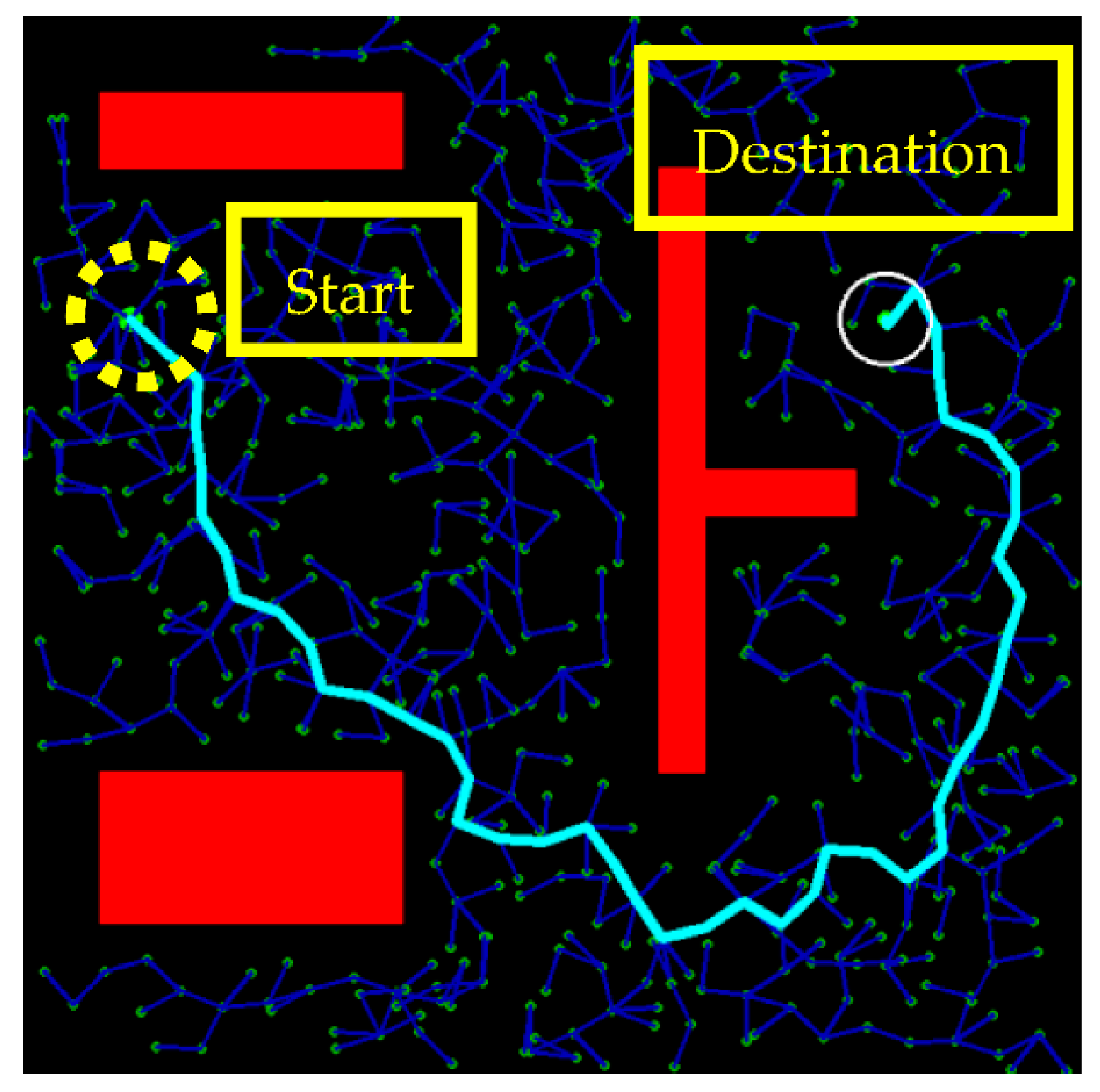
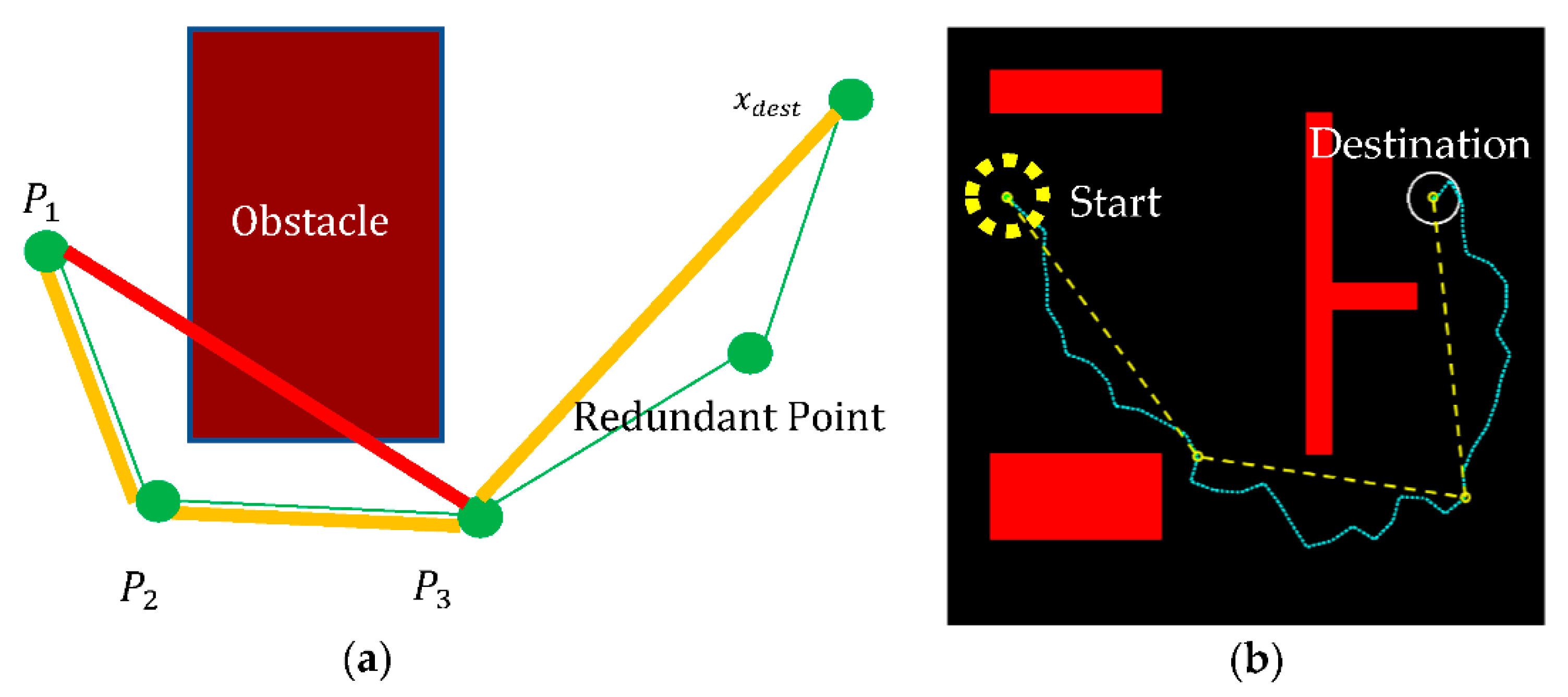
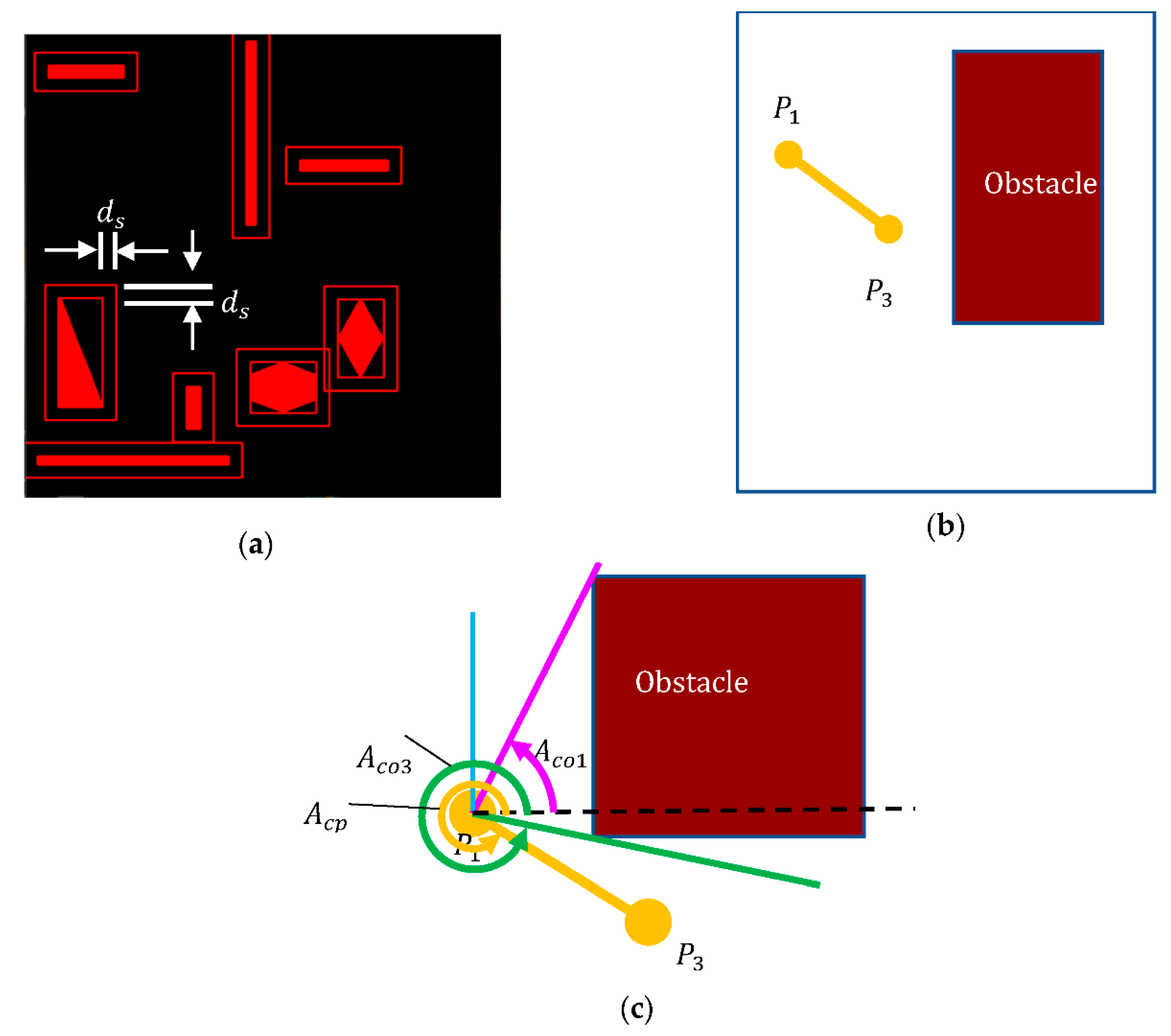
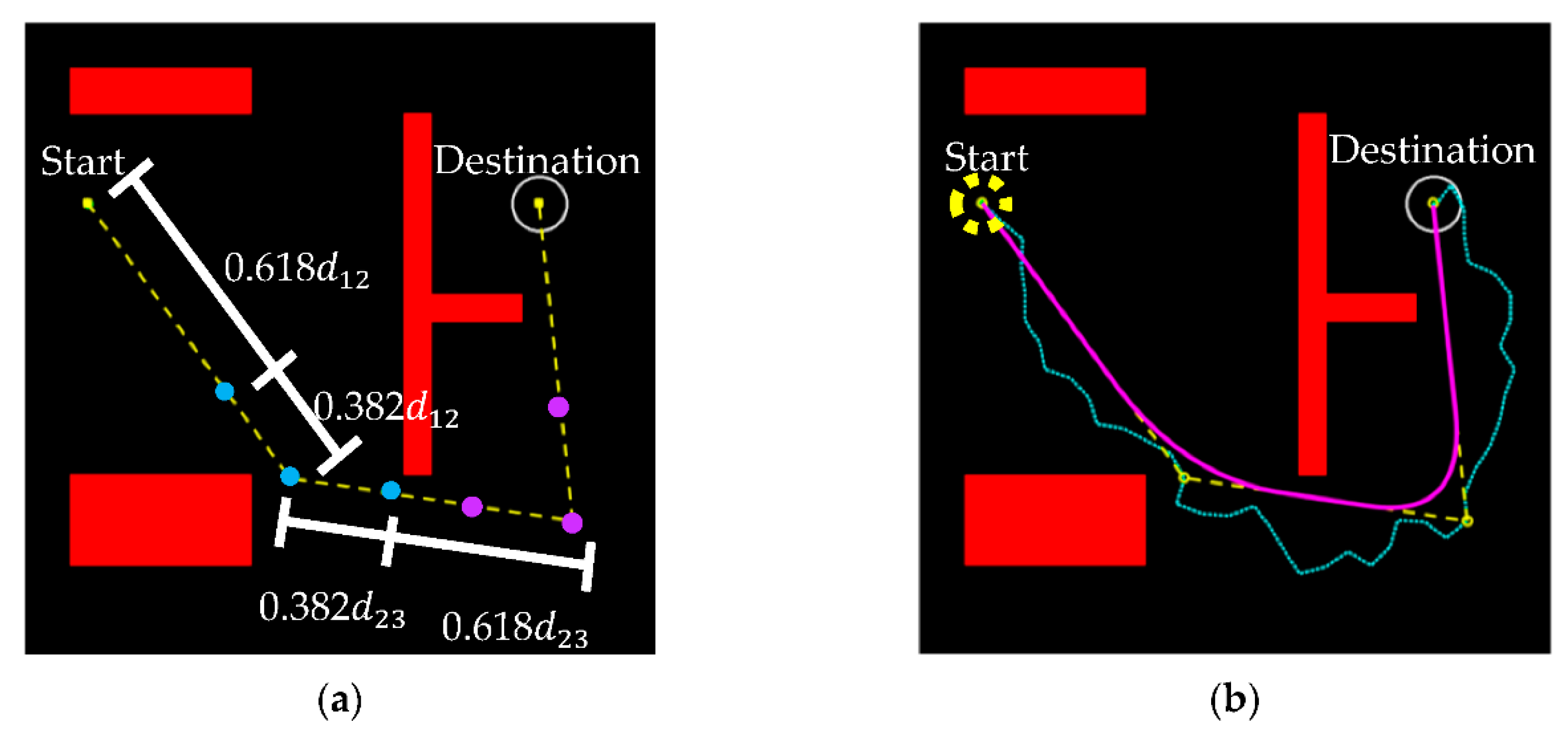

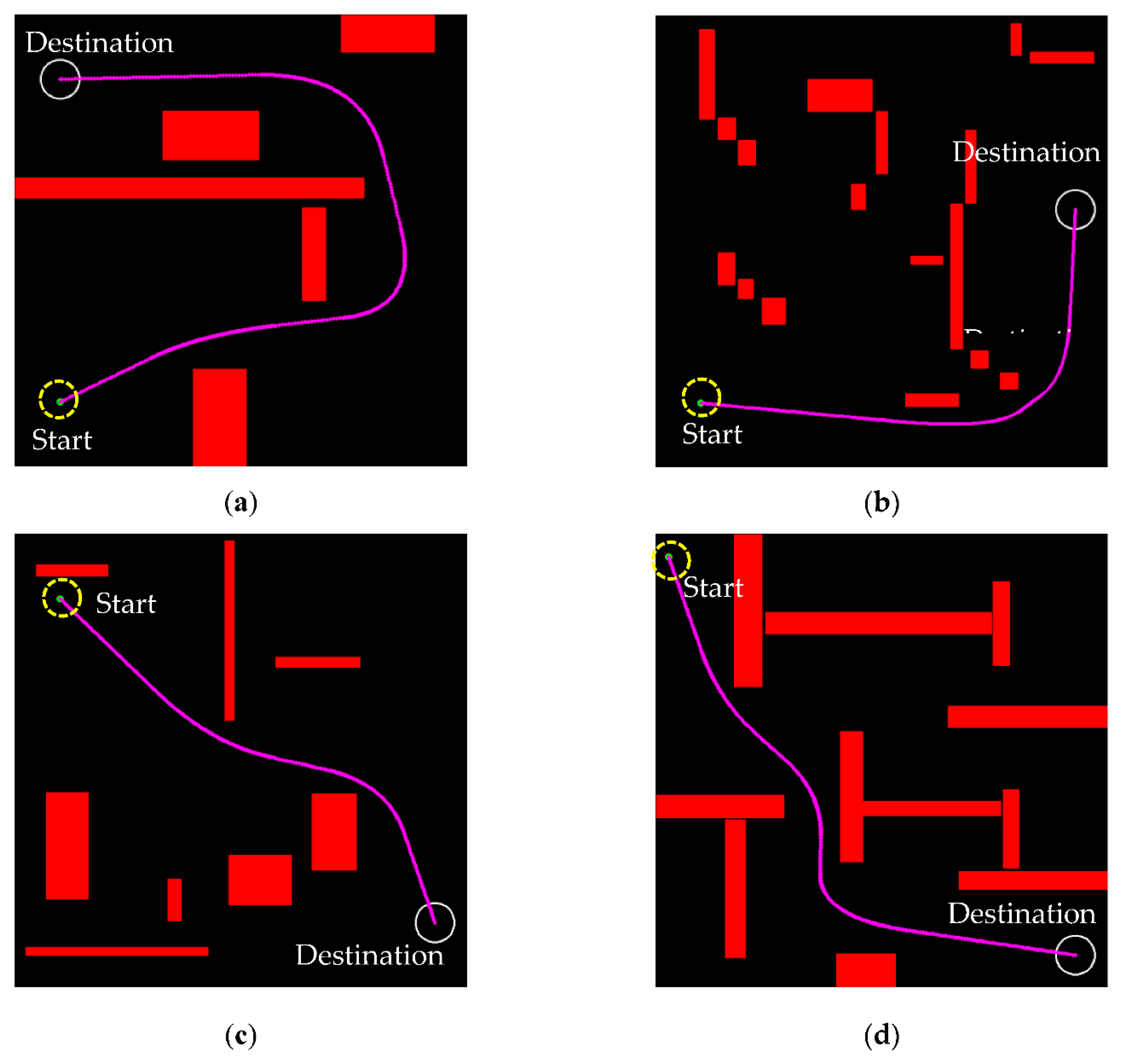
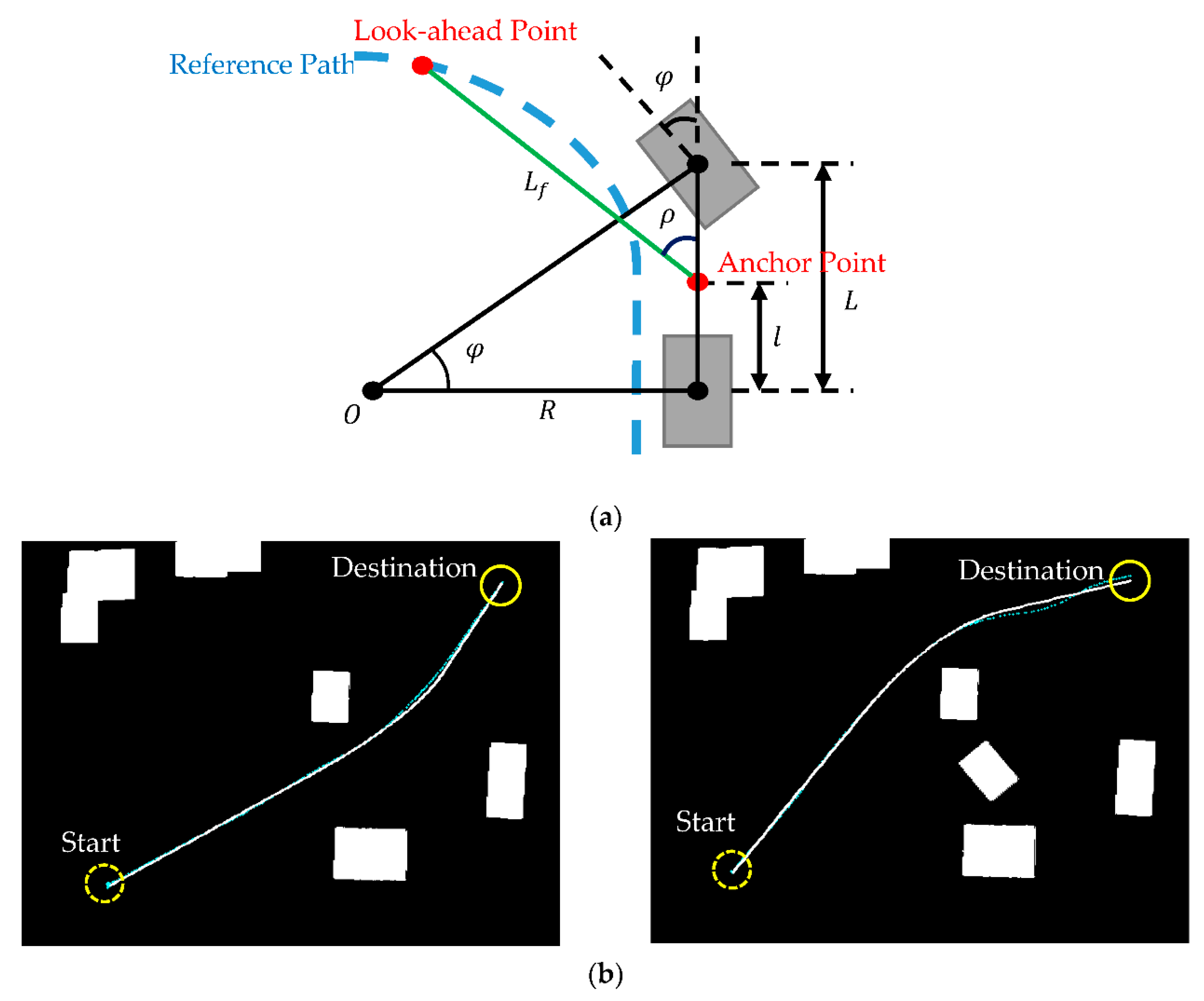

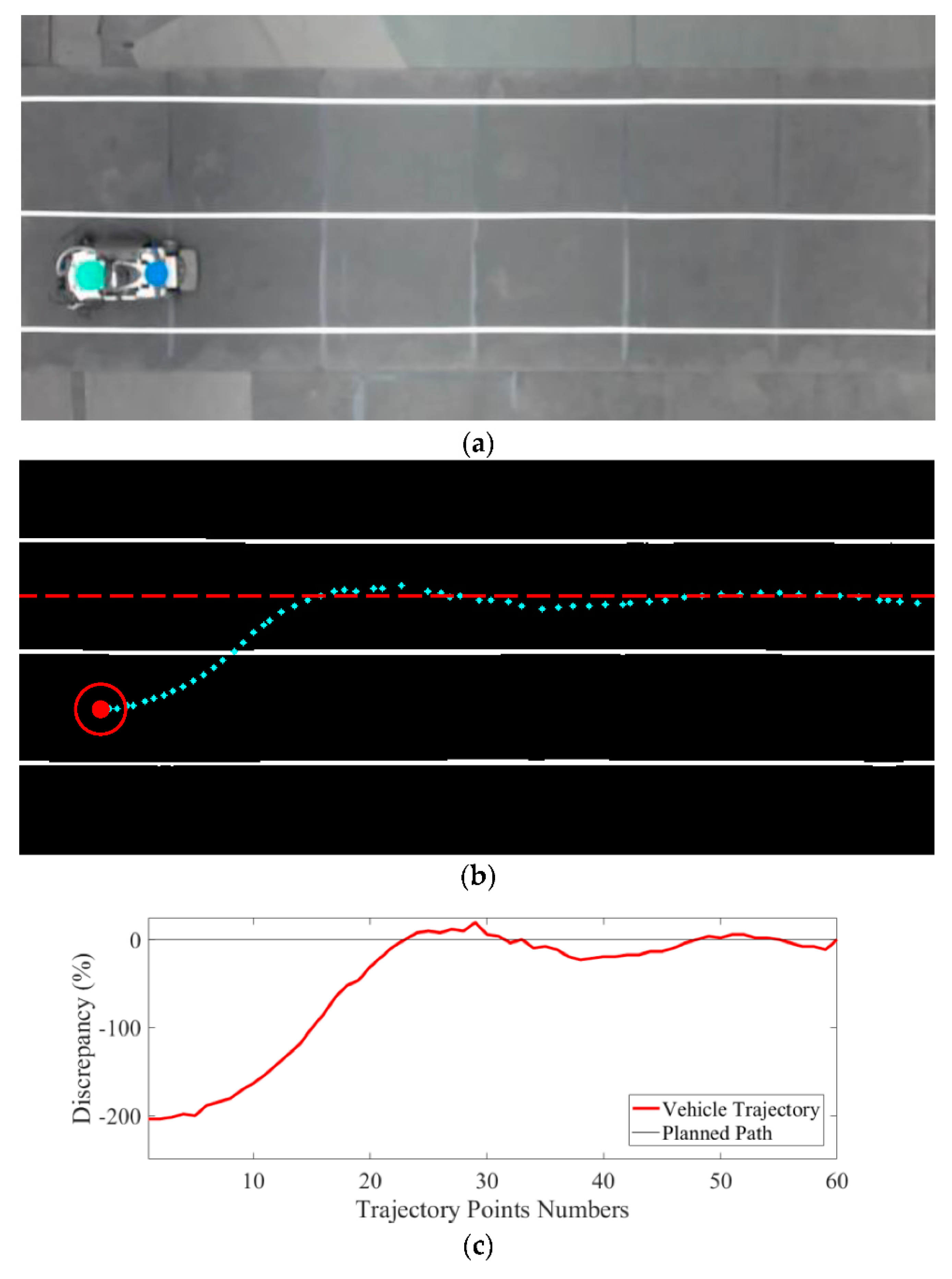
| Number of Repetitions | Success Rate (%) | Average Calculation Time (ms) |
|---|---|---|
| 1 | 56 | 91 |
| 5 | 74 | 420 |
| 10 | 96 | 900 |
| RRT Algorithm | With Pruning | With Pruning and Optimization |
|---|---|---|
| 1043 | 776 | 583 |
Publisher’s Note: MDPI stays neutral with regard to jurisdictional claims in published maps and institutional affiliations. |
© 2021 by the authors. Licensee MDPI, Basel, Switzerland. This article is an open access article distributed under the terms and conditions of the Creative Commons Attribution (CC BY) license (http://creativecommons.org/licenses/by/4.0/).
Share and Cite
Yang, S.M.; Lin, Y.A. Development of an Improved Rapidly Exploring Random Trees Algorithm for Static Obstacle Avoidance in Autonomous Vehicles. Sensors 2021, 21, 2244. https://doi.org/10.3390/s21062244
Yang SM, Lin YA. Development of an Improved Rapidly Exploring Random Trees Algorithm for Static Obstacle Avoidance in Autonomous Vehicles. Sensors. 2021; 21(6):2244. https://doi.org/10.3390/s21062244
Chicago/Turabian StyleYang, S. M., and Y. A. Lin. 2021. "Development of an Improved Rapidly Exploring Random Trees Algorithm for Static Obstacle Avoidance in Autonomous Vehicles" Sensors 21, no. 6: 2244. https://doi.org/10.3390/s21062244
APA StyleYang, S. M., & Lin, Y. A. (2021). Development of an Improved Rapidly Exploring Random Trees Algorithm for Static Obstacle Avoidance in Autonomous Vehicles. Sensors, 21(6), 2244. https://doi.org/10.3390/s21062244





